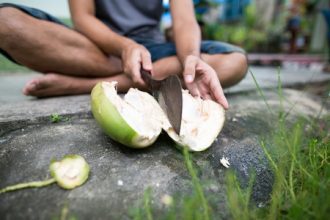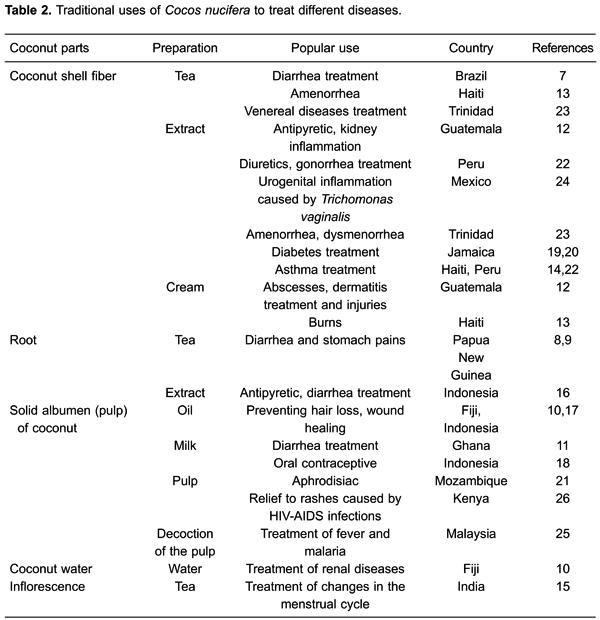By Sayer Ji
Contributing writer for Wake Up World
Besides hemp, there are few if any plants that produce as much food, shelter, and medicine as the coconut palm.
A scientific review on the coconut palm (Cocos nucifera), which is referred to as “the most naturally widespread fruit plant on Earth”, reveals numerous beneficial biological effects of its various constituents, which include the husk, root, oil, water, and flesh. The study, titled “Cocos nucifera (L.) (Arecaceae): A phytochemical and pharmacological review,” also reviewed the toxicity literature on the coconut palm’s various constituents and found there was no evidence of acute toxicity, and only low toxicity associated with chronic exposure.
The study summarized the story of the coconut palm’s fascinating spread around the world as follows: “The plant is originally from Southeast Asia (Malaysia, Indonesia, and the Philippines) and the islands between the Indian and Pacific Oceans. From that region, the fruit of the coconut palm is believed to have been brought to India and then to East Africa. After the discovery of the Cape of Good Hope, this plant was introduced into West Africa and, from there, dispersed to the American continent and to other tropical regions of the globe.”
The review also summarized the traditional healing applications of the coconut palm. This is an important complementary data set, because though many of the traditional uses have not yet been tested and validated by science, they may actually work exceptionally well for these conditions in actual practice.
Below is a table showing many of these traditional uses:
The traditional uses were also summarized in the following paragraph:
“In Brazil, extract from the husk fiber of C. nucifera is used to treat diarrhea (7). In Papua New Guinea, the leaves and roots of young plants are chewed as treatment for diarrhea and stomachaches (8,9). In Fiji, coconut oil is used to prevent hair loss and coconut water is used to treat renal disease (10). In Ghana, people use coconut milk to treat diarrhea (11). In Guatemala, the husk fiber extract is used as an antipyretic, to reduce renal inflammation, and as a topic ointment for dermatitis, abscesses, and injuries (12). In Haiti, a decoction of the dry pericarp is used for oral treatment of amenorrhea, and the oil is applied as an ointment to burns (13); an aqueous extract from the husk fiber is also used for oral asthma treatment (14). In India, infusions made with the coconut inflorescence are used for the oral treatment of menstrual cycle disorders (15). In Indonesia, the oil is used as a wound ointment, the coconut milk is used as an oral contraceptive, and fever and diarrhea are treated with the root extract (16–18). In Jamaica, the husk fiber extract is used to treat diabetes (19,20). In Mozambique, the fruit is consumed by men as an aphrodisiac (21). Peruvians use the aqueous extract of the fresh coconut fiber orally for asthma, as a diuretic, and for gonorrhea (22). In Trinidad, bark extract is used orally for amenorrhea and dysmenorrhea, and bark tea is used to treat venereal diseases (23). In Mexico, coconut is used to treat various disorders associated with urogenital tract infection by Trichomonas vaginalis (24). A decoction of the white flesh of the fruit is used in rural Malaysia to treat fever and malaria (25). In Kenya, the fruit is used to relieve skin rash caused by HIV infection (26).”
The study concluded:
“Cocos nucifera is a widely dispersed plant that has important pharmacological effects with low toxicity. Furthermore, medicinal use of C. nucifera has an environmental appeal, since this plant is widely used in the food industry and use of discarded plant parts will reduce waste and pollution. The pharmacological effects of the plant differ according to the part of the plant or fruit used. Antioxidant activity predominated in the constituents of the endocarp and coconut water. In addition, the fiber showed antibacterial, antiparasitic, and anti-inflammatory activities. Only the ethanolic extract of the root had depressant and anticonvulsant action on the central nervous system. Coconut water seems to have protective effects, e.g., on the kidney and heart, and antioxidant activity, as well as a hypoglycemic effect.”
Please note: The GreenMedInfo.com database presently contains research on the coconut palm’s potential therapeutic value in preventing and/or treating over 50 different conditions, and expressing 16 different beneficial biological effects. You can view the supporting studies on GreenMedInfo’s coconut research page.
About the author:
Sayer Ji is the founder of GreenMedInfo.com – an open access, evidence-based resource supporting natural and integrative modalities. He is on the Board of Governors for the National Health Federation and Fearless Parent, a Steering Committee Member of the Global GMO-Free Coalition (GGFC), a reviewer at the International Journal of Human Nutrition and Functional Medicine. Since 2003, Sayer has also served as a patient advocate and an educator and consultant for the natural health and wellness field.
For more, visit GreenMedInfo.com and Facebook/GreenMedInfo, or sign up for GreenMedInfo’s free e-Newsletter.
Recommended articles by Sayer Ji:
- Acupuncture Beats Injected Morphine for Pain: Groundbreaking Study
- Group Drumming Better Than Prozac, Study Suggests
- Mammography Is Harmful and Should Be Abandoned, Scientific Review Concludes
- “Killer Germs” Obliterated by Medicinal Smoke Smudging, Study Reveals
- 6 Evidence-Based Ways Drumming Heals Body, Mind and Soul
- Coconut Water: A New Alzheimer’s Disease Treatment?
- Turmeric’s ‘Smart Kill’ Properties Put Chemo & Radiation To Shame
- Tylenol Kills Emotions As Well As Pain, Study Reveals
- Beet Juice Boosts Cognitive Function In One Dose
- 13 Evidence-Based Medicinal Properties of Coconut Oil
- 25 Cancer Stem-Cell Killing Foods That Are Smarter Than Chemo and Radiation
- Roundup Weed Killer (Glyphosate) Threatens Coral Reefs, Persists In Seawater

If you've ever found value in our articles, we'd greatly appreciate your support by purchasing Mindful Meditation Techniques for Kids - A Practical Guide for Adults to Empower Kids with the Gift of Inner Peace and Resilience for Life.
In the spirit of mindfulness, we encourage you to choose the paperback version. Delve into its pages away from screen glare and notifications, allowing yourself to fully immerse in the transformative practices within. The physical book enriches the learning process and serves as a tangible commitment to mindfulness, easily shared among family and friends.
Over the past few years, Wake Up World has faced significant online censorship, impacting our financial ability to stay online. Instead of soliciting donations, we're exploring win-win solutions with our readers to remain financially viable. Moving into book publishing, we hope to secure ongoing funds to continue our mission. With over 8,500 articles published in the past 13 years, we are committed to keeping our content free and accessible to everyone, without resorting to a paywall.










